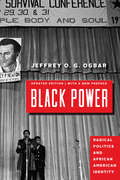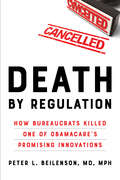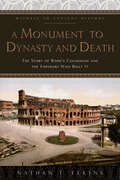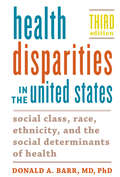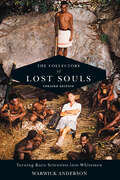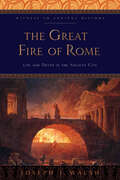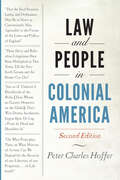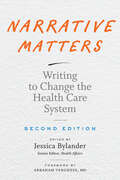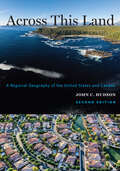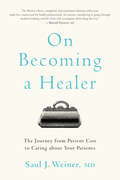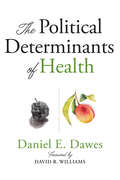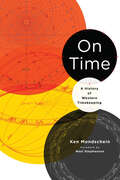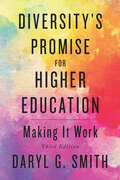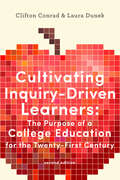- Table View
- List View
Black Power: Radical Politics and African American Identity
by Jeffrey O. G. OgbarOutstanding Academic Title, ChoiceIn the 1960s and 70s, the two most important black nationalist organizations, the Nation of Islam and the Black Panther Party, gave voice and agency to the most economically and politically isolated members of black communities outside the South. Though vilified as fringe and extremist, these movements proved to be formidable agents of influence during the civil rights era, ultimately giving birth to the Black Power movement.Drawing on deep archival research and interviews with key participants, Jeffrey O. G. Ogbar reconsiders the commingled stories of;¢;‚¬;€?and popular reactions to;¢;‚¬;€?the Nation of Islam, Black Panthers, and mainstream civil rights leaders. Ogbar finds that many African Americans embraced the seemingly contradictory political agenda of desegregation and nationalism. Indeed, black nationalism, he demonstrates, was far more favorably received among African Americans than historians have previously acknowledged. It engendered minority pride and influenced the political, cultural, and religious spheres of mainstream African American life for the decades to come.This updated edition of Ogbar's classic work contains a new preface that describes the book's genesis and links the Black Power movement to the Black Lives Matter movement. A thoroughly updated essay on sources contains a comprehensive review of Black Power;€“related scholarship. Ultimately, Black Power reveals a black freedom movement in which the ideals of desegregation through nonviolence and black nationalism marched side by side.
Black Power: Radical Politics and African American Identity
by Jeffrey O. G. OgbarOutstanding Academic Title, ChoiceIn the 1960s and 70s, the two most important black nationalist organizations, the Nation of Islam and the Black Panther Party, gave voice and agency to the most economically and politically isolated members of black communities outside the South. Though vilified as fringe and extremist, these movements proved to be formidable agents of influence during the civil rights era, ultimately giving birth to the Black Power movement.Drawing on deep archival research and interviews with key participants, Jeffrey O. G. Ogbar reconsiders the commingled stories of;¢;‚¬;€?and popular reactions to;¢;‚¬;€?the Nation of Islam, Black Panthers, and mainstream civil rights leaders. Ogbar finds that many African Americans embraced the seemingly contradictory political agenda of desegregation and nationalism. Indeed, black nationalism, he demonstrates, was far more favorably received among African Americans than historians have previously acknowledged. It engendered minority pride and influenced the political, cultural, and religious spheres of mainstream African American life for the decades to come.This updated edition of Ogbar's classic work contains a new preface that describes the book's genesis and links the Black Power movement to the Black Lives Matter movement. A thoroughly updated essay on sources contains a comprehensive review of Black Power;€“related scholarship. Ultimately, Black Power reveals a black freedom movement in which the ideals of desegregation through nonviolence and black nationalism marched side by side.
Death by Regulation: How Bureaucrats Killed One of Obamacare's Promising Innovations
by Peter L. BeilensonIn the contentious run-up to the passage of the Affordable Care Act, Congress passed a law to make nonprofit health insurance CO-OPs (formally known as Consumer Operated and Oriented Plans) a viable alternative to the public option. The idea was to create new competition in order to lower health insurance premiums and encourage innovation. Nearly two dozen such low-cost CO-OPs were launched in the wake of the ACA's passage; only four are in operation today.In Death by Regulation, Dr. Peter L. Beilenson tells the story of a group of Maryland-based public health professionals who launched the Evergreen Health Cooperative, only to discover that the ACA law encouraging CO-OPs was a "plastic plant"—a piece of legislation created for optics but never intended to be functional. Over most of its four years of existence, Evergreen succeeded against all odds, prevailing over naysayers, big insurance companies, Congress, and its founders' naïveté. But in an ironic twist, it was bureaucratic hostility from the Centers for Medicare and Medicaid Services—the very Obama administration agency responsible for the CO-OPs—that led to their collective demise.Beilenson traces the huge impact of seemingly small policy decisions on the work of his team and the people their CO-OP was built to serve. He recounts the excitement and satisfaction of launching such a valuable healthcare company, as well as the damage done to scores of employees and tens of thousands of satisfied healthcare customers when bureaucrats ran amok. The only book about these idealistic Obamacare CO-OPs and the obstacles they all faced, Death by Regulation offers an insider view of health policy and the reality of starting an insurance company from scratch.
Death by Regulation: How Bureaucrats Killed One of Obamacare's Promising Innovations
by Peter L. BeilensonIn the contentious run-up to the passage of the Affordable Care Act, Congress passed a law to make nonprofit health insurance CO-OPs (formally known as Consumer Operated and Oriented Plans) a viable alternative to the public option. The idea was to create new competition in order to lower health insurance premiums and encourage innovation. Nearly two dozen such low-cost CO-OPs were launched in the wake of the ACA's passage; only four are in operation today.In Death by Regulation, Dr. Peter L. Beilenson tells the story of a group of Maryland-based public health professionals who launched the Evergreen Health Cooperative, only to discover that the ACA law encouraging CO-OPs was a "plastic plant"—a piece of legislation created for optics but never intended to be functional. Over most of its four years of existence, Evergreen succeeded against all odds, prevailing over naysayers, big insurance companies, Congress, and its founders' naïveté. But in an ironic twist, it was bureaucratic hostility from the Centers for Medicare and Medicaid Services—the very Obama administration agency responsible for the CO-OPs—that led to their collective demise.Beilenson traces the huge impact of seemingly small policy decisions on the work of his team and the people their CO-OP was built to serve. He recounts the excitement and satisfaction of launching such a valuable healthcare company, as well as the damage done to scores of employees and tens of thousands of satisfied healthcare customers when bureaucrats ran amok. The only book about these idealistic Obamacare CO-OPs and the obstacles they all faced, Death by Regulation offers an insider view of health policy and the reality of starting an insurance company from scratch.
A Monument to Dynasty and Death: The Story of Rome's Colosseum and the Emperors Who Built It (Witness to Ancient History)
by Nathan T. ElkinsEarly one morning in 80 CE, the Colosseum roared to life with the deafening cheers of tens of thousands of spectators as the emperor, Titus, inaugurated the new amphitheater with one hundred days of bloody spectacles. These games were much anticipated, for the new amphitheater had been under construction for a decade. Home to spectacles involving exotic beasts, elaborate executions of criminals, gladiatorial combats, and even—when flooded—small-scale naval battles, the building itself was also a marvel. Rising to a height of approximately 15 stories and occupying an area of 6 acres—more than four times the size of a modern football field—the Colosseum was the largest of all amphitheaters in the Roman Empire. In A Monument to Dynasty and Death, Nathan T. Elkins tells the story of the Colosseum's construction under Vespasian, its dedication under Titus, and further enhancements added under Domitian. The Colosseum, Elkins argues, was far more than a lavish entertainment venue: it was an ideologically charged monument to the new dynasty, its aspirations, and its achievements. A Monument to Dynasty and Death takes readers on a behind-the-scenes tour of the Colosseum from the subterranean tunnels, where elevators and cages transported gladiators and animals to the blood-soaked arena floor, to the imperial viewing box, to the amphitheater's decoration and amenities, such as fountains and an awning to shade spectators. Trained as an archaeologist, an art historian, and a historian of ancient Rome, Elkins deploys an interdisciplinary approach that draws on contemporary historical texts, inscriptions, archaeology, and visual evidence to convey the layered ideological messages communicated by the Colosseum. This engaging book is an excellent resource for classes on Roman art, architecture, history, civilization, and sport and spectacle.
A Monument to Dynasty and Death: The Story of Rome's Colosseum and the Emperors Who Built It (Witness to Ancient History)
by Nathan T. ElkinsEarly one morning in 80 CE, the Colosseum roared to life with the deafening cheers of tens of thousands of spectators as the emperor, Titus, inaugurated the new amphitheater with one hundred days of bloody spectacles. These games were much anticipated, for the new amphitheater had been under construction for a decade. Home to spectacles involving exotic beasts, elaborate executions of criminals, gladiatorial combats, and even—when flooded—small-scale naval battles, the building itself was also a marvel. Rising to a height of approximately 15 stories and occupying an area of 6 acres—more than four times the size of a modern football field—the Colosseum was the largest of all amphitheaters in the Roman Empire. In A Monument to Dynasty and Death, Nathan T. Elkins tells the story of the Colosseum's construction under Vespasian, its dedication under Titus, and further enhancements added under Domitian. The Colosseum, Elkins argues, was far more than a lavish entertainment venue: it was an ideologically charged monument to the new dynasty, its aspirations, and its achievements. A Monument to Dynasty and Death takes readers on a behind-the-scenes tour of the Colosseum from the subterranean tunnels, where elevators and cages transported gladiators and animals to the blood-soaked arena floor, to the imperial viewing box, to the amphitheater's decoration and amenities, such as fountains and an awning to shade spectators. Trained as an archaeologist, an art historian, and a historian of ancient Rome, Elkins deploys an interdisciplinary approach that draws on contemporary historical texts, inscriptions, archaeology, and visual evidence to convey the layered ideological messages communicated by the Colosseum. This engaging book is an excellent resource for classes on Roman art, architecture, history, civilization, and sport and spectacle.
Health Disparities in the United States: Social Class, Race, Ethnicity, and the Social Determinants of Health
by Donald A. BarrThe health care system in the United States has been called the best in the world. Yet wide disparities persist between social groups, and many Americans suffer from poorer health than people in other developed countries. In this revised edition of Health Disparities in the United States, Donald A. Barr provides extensive new data about the ways low socioeconomic status, race, and ethnicity interact to create and perpetuate these health disparities. Examining the significance of this gulf for the medical community and society at large, Barr offers potential policy- and physician-based solutions for reducing health inequity in the long term.This thoroughly updated edition focuses on a new challenge the United States last experienced more than half a century ago: successive years of declining life expectancy. Barr addresses the causes of this decline, including what are commonly referred to as "deaths of despair"—from opiate overdose or suicide. Exploring the growing role geography plays in health disparities, Barr asks why people living in rural areas suffer the greatest increases in these deaths. He also analyzes recent changes under the Affordable Care Act and considers the literature on how race and ethnicity affect the way health care providers evaluate and treat patients.As both a physician and a sociologist, Barr is uniquely positioned to offer rigorous medical explanations alongside sociological analysis. An essential text for courses in public health, health policy, and sociology, this compelling book is a vital teaching tool and a comprehensive reference for social science and medical professionals.
Health Disparities in the United States: Social Class, Race, Ethnicity, and the Social Determinants of Health
by Donald A. BarrThe health care system in the United States has been called the best in the world. Yet wide disparities persist between social groups, and many Americans suffer from poorer health than people in other developed countries. In this revised edition of Health Disparities in the United States, Donald A. Barr provides extensive new data about the ways low socioeconomic status, race, and ethnicity interact to create and perpetuate these health disparities. Examining the significance of this gulf for the medical community and society at large, Barr offers potential policy- and physician-based solutions for reducing health inequity in the long term.This thoroughly updated edition focuses on a new challenge the United States last experienced more than half a century ago: successive years of declining life expectancy. Barr addresses the causes of this decline, including what are commonly referred to as "deaths of despair"—from opiate overdose or suicide. Exploring the growing role geography plays in health disparities, Barr asks why people living in rural areas suffer the greatest increases in these deaths. He also analyzes recent changes under the Affordable Care Act and considers the literature on how race and ethnicity affect the way health care providers evaluate and treat patients.As both a physician and a sociologist, Barr is uniquely positioned to offer rigorous medical explanations alongside sociological analysis. An essential text for courses in public health, health policy, and sociology, this compelling book is a vital teaching tool and a comprehensive reference for social science and medical professionals.
The Collectors of Lost Souls: Turning Kuru Scientists into Whitemen
by Warwick AndersonWinner, William H. Welch Medal, American Association for the History of MedicineWinner, Ludwik Fleck Prize, Society for Social Studies of ScienceWinner, General History Award, New South Wales Premier's History AwardsWhen whites first encountered the Fore people in the isolated highlands of colonial New Guinea during the 1940s and 1950s, they found a people in the grip of a bizarre epidemic. Women and children succumbed to muscle weakness, uncontrollable tremors, and lack of coordination, until death inevitably supervened. Facing extinction, the Fore attributed their unique and terrifying affliction to a particularly malign form of sorcery.In The Collectors of Lost Souls, Warwick Anderson tells the story of the resilience of the Fore through this devastating plague, their transformation into modern people, and their compelling attraction for a throng of eccentric and adventurous scientists and anthropologists. Battling competing scientists and the colonial authorities, the brilliant and troubled American doctor D. Carleton Gajdusek determined that the cause of the epidemic—kuru—was a new and mysterious agent of infection, which he called a slow virus (now called a prion). Anthropologists and epidemiologists soon realized that the Fore practice of eating their loved ones after death had spread the slow virus. Though the Fore were never convinced, Gajdusek received the Nobel Prize for his discovery. Now revised and updated, the book includes an extensive new afterword that situates its impact within the fields of science and technology studies and the history of science. Additionally, the author now reflects on his long engagement with the scientists and the people afflicted, describing what has happened to them since the end of kuru. This astonishing story links first-contact encounters in New Guinea with laboratory experiments in Bethesda, Maryland; sorcery with science; cannibalism with compassion; and slow viruses with infectious proteins, reshaping our understanding of what it means to do science.
The Collectors of Lost Souls: Turning Kuru Scientists into Whitemen
by Warwick AndersonWinner, William H. Welch Medal, American Association for the History of MedicineWinner, Ludwik Fleck Prize, Society for Social Studies of ScienceWinner, General History Award, New South Wales Premier's History AwardsWhen whites first encountered the Fore people in the isolated highlands of colonial New Guinea during the 1940s and 1950s, they found a people in the grip of a bizarre epidemic. Women and children succumbed to muscle weakness, uncontrollable tremors, and lack of coordination, until death inevitably supervened. Facing extinction, the Fore attributed their unique and terrifying affliction to a particularly malign form of sorcery.In The Collectors of Lost Souls, Warwick Anderson tells the story of the resilience of the Fore through this devastating plague, their transformation into modern people, and their compelling attraction for a throng of eccentric and adventurous scientists and anthropologists. Battling competing scientists and the colonial authorities, the brilliant and troubled American doctor D. Carleton Gajdusek determined that the cause of the epidemic—kuru—was a new and mysterious agent of infection, which he called a slow virus (now called a prion). Anthropologists and epidemiologists soon realized that the Fore practice of eating their loved ones after death had spread the slow virus. Though the Fore were never convinced, Gajdusek received the Nobel Prize for his discovery. Now revised and updated, the book includes an extensive new afterword that situates its impact within the fields of science and technology studies and the history of science. Additionally, the author now reflects on his long engagement with the scientists and the people afflicted, describing what has happened to them since the end of kuru. This astonishing story links first-contact encounters in New Guinea with laboratory experiments in Bethesda, Maryland; sorcery with science; cannibalism with compassion; and slow viruses with infectious proteins, reshaping our understanding of what it means to do science.
The Great Fire of Rome: Life and Death in the Ancient City (Witness to Ancient History)
by Joseph J. WalshPeril was everywhere in ancient Rome, but the Great Fire of 64 CE was unlike anything the city had ever experienced. No building, no neighborhood, no person was safe from conflagration. When the fire finally subsided—after burning for nine days straight—vast swaths of Rome were in ruins. The greatest city of the ancient world had endured its greatest blow. In The Great Fire of Rome, Joseph J. Walsh tells the true story of this deadly episode in Rome's history. He explains why Rome was such a vulnerable tinderbox, outlines the difficulties of life in that exciting and dangerous city, and recounts the fire's aftermath and legacy—a legacy that includes the transformation of much of ancient Rome into a modern city. Situating the fire within the context of other perils that residents of Rome faced, including frequent flooding, pollution, crime, and dangerously shoddy construction, he highlights the firefighting technology of the period and examines the ways in which the city's architecture and planning contributed to the severity of the blaze. Introducing readers to the grim realities of life in that overwhelming and overwhelmed city while chronicling its later glories, The Great Fire of Rome is grounded in the latest scholarship on fire analysis and forensics. Walsh's multifaceted analysis, balanced insights, and concise, accessible prose make this book a versatile teaching tool. Readers interested in ancient (and modern) Rome, urban life, and civic disasters, among other things, will be fascinated by this book.
The Great Fire of Rome: Life and Death in the Ancient City (Witness to Ancient History)
by Joseph J. WalshPeril was everywhere in ancient Rome, but the Great Fire of 64 CE was unlike anything the city had ever experienced. No building, no neighborhood, no person was safe from conflagration. When the fire finally subsided—after burning for nine days straight—vast swaths of Rome were in ruins. The greatest city of the ancient world had endured its greatest blow. In The Great Fire of Rome, Joseph J. Walsh tells the true story of this deadly episode in Rome's history. He explains why Rome was such a vulnerable tinderbox, outlines the difficulties of life in that exciting and dangerous city, and recounts the fire's aftermath and legacy—a legacy that includes the transformation of much of ancient Rome into a modern city. Situating the fire within the context of other perils that residents of Rome faced, including frequent flooding, pollution, crime, and dangerously shoddy construction, he highlights the firefighting technology of the period and examines the ways in which the city's architecture and planning contributed to the severity of the blaze. Introducing readers to the grim realities of life in that overwhelming and overwhelmed city while chronicling its later glories, The Great Fire of Rome is grounded in the latest scholarship on fire analysis and forensics. Walsh's multifaceted analysis, balanced insights, and concise, accessible prose make this book a versatile teaching tool. Readers interested in ancient (and modern) Rome, urban life, and civic disasters, among other things, will be fascinated by this book.
Law and People in Colonial America
by Peter Charles HofferHow did American colonists transform British law into their own? What were the colonies' first legal institutions, and who served in them? And why did the early Americans develop a passion for litigation that continues to this day? In Law and People in Colonial America, Peter Charles Hoffer tells the story of early American law from its beginnings on the British mainland to its maturation during the crisis of the American Revolution. For the men and women of colonial America, Hoffer explains, law was a pervasive influence in everyday life. Because it was their law, the colonists continually adapted it to fit changing circumstances. They also developed a sense of legalism that influenced virtually all social, economic, and political relationships. This sense of intimacy with the law, Hoffer argues, assumed a transforming power in times of crisis. In the midst of a war for independence, American revolutionaries used their intimacy with the law to explain how their rebellion could be lawful, while legislators wrote republican constitutions that would endure for centuries.Today the role of law in American life is more pervasive than ever. And because our system of law involves a continuing dialogue between past and present, interpreting the meaning of precedent and of past legislation, the study of legal history is a vital part of every citizen's basic education. Taking advantage of rich new scholarship that goes beyond traditional approaches to view slavery as a fundamental cultural and social institution as well as an economic one, this second edition includes an extensive, entirely new chapter on colonial and revolutionary-era slave law. Law and People in Colonial America is a lively introduction to early American law. It makes for essential reading.
Law and People in Colonial America
by Peter Charles HofferHow did American colonists transform British law into their own? What were the colonies' first legal institutions, and who served in them? And why did the early Americans develop a passion for litigation that continues to this day? In Law and People in Colonial America, Peter Charles Hoffer tells the story of early American law from its beginnings on the British mainland to its maturation during the crisis of the American Revolution. For the men and women of colonial America, Hoffer explains, law was a pervasive influence in everyday life. Because it was their law, the colonists continually adapted it to fit changing circumstances. They also developed a sense of legalism that influenced virtually all social, economic, and political relationships. This sense of intimacy with the law, Hoffer argues, assumed a transforming power in times of crisis. In the midst of a war for independence, American revolutionaries used their intimacy with the law to explain how their rebellion could be lawful, while legislators wrote republican constitutions that would endure for centuries.Today the role of law in American life is more pervasive than ever. And because our system of law involves a continuing dialogue between past and present, interpreting the meaning of precedent and of past legislation, the study of legal history is a vital part of every citizen's basic education. Taking advantage of rich new scholarship that goes beyond traditional approaches to view slavery as a fundamental cultural and social institution as well as an economic one, this second edition includes an extensive, entirely new chapter on colonial and revolutionary-era slave law. Law and People in Colonial America is a lively introduction to early American law. It makes for essential reading.
Narrative Matters: Writing to Change the Health Care System
by Jessica BylanderHealth care decision making affects patients and families first and foremost, yet their perspectives are not always factored into health policy deliberations and discussions. In this anthology, Jessica Bylander brings together the personal stories of the patients, physicians, caregivers, policy makers, and others whose writings add much-needed human context to health care decision making.Drawn from the popular "Narrative Matters" column in the leading health policy journal Health Affairs, this collection features essays by some of the leading minds in health care today, including Pulitzer Prize–winner Siddhartha Mukherjee, MacArthur fellow Diane Meier, former Planned Parenthood president Leana S. Wen, and former secretary of health and human services Louis W. Sullivan. The collection also presents important stories from lesser-known voices, including a transgender doctor in Oklahoma who calls for better treatment of trans patients and a palliative care physician who reflects on how perspectives on hastening death have changed in recent years. A foreword written by National Humanities Medal recipient Abraham Verghese, MD, further rounds out the book.The collection of thirty-two essays is organized around several themes:• the practice of medicine • medical innovation and research• patient-centered care• the doctor-patient relationship• disparities and discrimination• aging and end-of-life care• maternity and childbirth• opioids and substance abuseThe narratives in this timely and diverse collection remind readers of the real people affected by health policy decisions and offer clear calls for policy action to improve health care. Narrative Matters is a powerful argument for humane, patient-centered care.Contributors: Louise Aronson, Laura Arrowsmith, Cheryl Bettigole, Cindy Brach, Gary Epstein-Lubow, Jonathan Friedlaender, Patricia Gabow, Katti Gray, Yasmin Sokkar Harker, Timothy Hoff, Carla Keirns, Raya Elfadel Kheirbek, Katy B. Kozhimannil, Pooja Lagisetty, Maria Maldonado, Maureen A. Mavrinac, Diane E. Meier, Dina Keller Moss, Siddhartha Mukherjee, Donna Jackson Nakazawa, Travis N. Rieder, Aroonsiri Sangarlangkarn, Elaine Schattner, Janice Lynch Schuster, Myrick C. Shinall, Gayathri Subramanian, Louis W. Sullivan, Gautham K. Suresh, Abraham Verghese, Otis Warren, Leana S. Wen, Charlotte Yeh
Across This Land: A Regional Geography of the United States and Canada (Creating the North American Landscape)
by John HudsonBased on decades of research and written in clear, concise prose by one of the foremost geographers in North America, John C. Hudson's Across This Land is a comprehensive regional geography of the North American continent. Dividing the terrain into ten regions, which are then subdivided into twenty-seven smaller areas, Hudson's brisk narrative reveals the dynamic processes of each area's distinctive place-specific characteristics. Focusing on how human activities have shaped and have been shaped by the natural environment, Hudson considers physical, political, and historical geography. He also highlights related topics, including resource exploitation, economic development, and population change. Praised in its first edition as a readable and reliable interpretation of United States and Canadian geography, the revised Across This Land retains these strengths while adding substantial new material. Incorporating the latest available population and economic data, this thoroughly updated edition includes• reflections on new developments, such as resource schemes, Native governments in Atlantic Canada, and the role of climate change in the Arctic• a new section focused on the US Pacific insular territories west of Hawaii• evolving views of oil and gas production resulting from the introduction of hydraulic fracturing• revised text and maps involving agricultural production based on the 2017 Census of Agriculture• current place names• more than 130 photographsThe most extensive regional geography of the North American continent on the market, Hudson's Across This Land will continue as the standard text in geography courses dealing with Canada and the United States, as well as a popular reference work for scholars, students, and lay readers.
Across This Land: A Regional Geography of the United States and Canada (Creating the North American Landscape)
by John HudsonBased on decades of research and written in clear, concise prose by one of the foremost geographers in North America, John C. Hudson's Across This Land is a comprehensive regional geography of the North American continent. Dividing the terrain into ten regions, which are then subdivided into twenty-seven smaller areas, Hudson's brisk narrative reveals the dynamic processes of each area's distinctive place-specific characteristics. Focusing on how human activities have shaped and have been shaped by the natural environment, Hudson considers physical, political, and historical geography. He also highlights related topics, including resource exploitation, economic development, and population change. Praised in its first edition as a readable and reliable interpretation of United States and Canadian geography, the revised Across This Land retains these strengths while adding substantial new material. Incorporating the latest available population and economic data, this thoroughly updated edition includes• reflections on new developments, such as resource schemes, Native governments in Atlantic Canada, and the role of climate change in the Arctic• a new section focused on the US Pacific insular territories west of Hawaii• evolving views of oil and gas production resulting from the introduction of hydraulic fracturing• revised text and maps involving agricultural production based on the 2017 Census of Agriculture• current place names• more than 130 photographsThe most extensive regional geography of the North American continent on the market, Hudson's Across This Land will continue as the standard text in geography courses dealing with Canada and the United States, as well as a popular reference work for scholars, students, and lay readers.
On Becoming a Healer: The Journey from Patient Care to Caring about Your Patients
by Saul J. WeinerMedical students and physicians-in-training embark on a long journey that, although steeped in scientific learning and technical skill building, includes little guidance on the emotional and interpersonal dimensions of becoming a healer. Written for anyone in the health care community who hopes to grow emotionally and cognitively in the way they interact with patients, On Becoming a Healer explains how to foster doctor-patient relationships that are mutually nourishing. Dr. Saul J. Weiner, a physician-educator, argues that joy in medicine requires more than idealistic aspirations—it demands a capacity to see past the "otherness" that separates the well from the sick, the professional in a white coat from the disheveled patient in a hospital gown. Weiner scrutinizes the medical school indoctrination process and explains how it molds the physician's mindset into that of a task completer rather than a thoughtful professional. Taking a personal approach, Weiner describes his own journey to becoming an internist and pediatrician while offering concrete advice on how to take stock of your current development as a physician, how to openly and fully engage with patients, and how to establish clear boundaries that help defuse emotionally charged situations. Readers will learn how to counter judgmentalism, how to make medical decisions that take into account the whole patient, and how to incorporate the organizing principle of healing into their practice. Each chapter ends with questions for reflection and discussion to help personalize the lessons for individual learners.
On Becoming a Healer: The Journey from Patient Care to Caring about Your Patients
by Saul WeinerMedical students and physicians-in-training embark on a long journey that, although steeped in scientific learning and technical skill building, includes little guidance on the emotional and interpersonal dimensions of becoming a healer. Written for anyone in the health care community who hopes to grow emotionally and cognitively in the way they interact with patients, On Becoming a Healer explains how to foster doctor-patient relationships that are mutually nourishing. Dr. Saul J. Weiner, a physician-educator, argues that joy in medicine requires more than idealistic aspirations—it demands a capacity to see past the "otherness" that separates the well from the sick, the professional in a white coat from the disheveled patient in a hospital gown. Weiner scrutinizes the medical school indoctrination process and explains how it molds the physician's mindset into that of a task completer rather than a thoughtful professional. Taking a personal approach, Weiner describes his own journey to becoming an internist and pediatrician while offering concrete advice on how to take stock of your current development as a physician, how to openly and fully engage with patients, and how to establish clear boundaries that help defuse emotionally charged situations. Readers will learn how to counter judgmentalism, how to make medical decisions that take into account the whole patient, and how to incorporate the organizing principle of healing into their practice. Each chapter ends with questions for reflection and discussion to help personalize the lessons for individual learners.
The Political Determinants of Health
by Daniel E. DawesReduced life expectancy, worsening health outcomes, health inequity, and declining health care options—these are now realities for most Americans. However, in a country of more than 325 million people, addressing everyone's issues is challenging. How can we effect beneficial change for everyone so we all can thrive? What is the great equalizer? In this book, Daniel E. Dawes argues that political determinants of health create the social drivers—including poor environmental conditions, inadequate transportation, unsafe neighborhoods, and lack of healthy food options—that affect all other dynamics of health. By understanding these determinants, their origins, and their impact on the equitable distribution of opportunities and resources, we will be better equipped to develop and implement actionable solutions to close the health gap.Dawes draws on his firsthand experience helping to shape major federal policies, including the Affordable Care Act, to describe the history of efforts to address the political determinants that have resulted in health inequities. Taking us further upstream to the underlying source of the causes of inequities, Dawes examines the political decisions that lead to our social conditions, makes the social determinants of health more accessible, and provides a playbook for how we can address them effectively. A thought-provoking and evocative account that considers both the policies we think of as "health policy" and those that we don't, The Political Determinants of Health provides a novel, multidisciplinary framework for addressing the systemic barriers preventing the United States from becoming the healthiest nation in the world.
On Time: A History of Western Timekeeping
by Kenneth C. MondscheinWestern culture has been obsessed with regulating society by the precise, accurate measurement of time since the Middle Ages. In On Time, Ken Mondschein explores the paired development of concepts and technologies of timekeeping with human thought. Without clocks, he argues, the modern world as we know it would not exist. From the astronomical timekeeping of the ancient world to the tower clocks of the Middle Ages to the seagoing chronometer, the quartz watch, and the atomic clock, greater precision and accuracy have had profound effects on human society—which, in turn, has driven the quest for further precision and accuracy. This quest toward automation—which gave rise to the Gregorian calendar, the factory clock, and even the near-disastrous Y2K bug—has led to profound social repercussions and driven the creation of the modern scientific mindset. Surveying the evolution of the clock from prehistory to the twenty-first century, Mondschein explains how both the technology and the philosophy behind Western timekeeping regimes came to take over the entire world. On Time is a story of thinkers, philosophers, and scientists, and of the thousand decisions that continue to shape our daily lives.
On Time: A History of Western Timekeeping
by Kenneth C. MondscheinWestern culture has been obsessed with regulating society by the precise, accurate measurement of time since the Middle Ages. In On Time, Ken Mondschein explores the paired development of concepts and technologies of timekeeping with human thought. Without clocks, he argues, the modern world as we know it would not exist. From the astronomical timekeeping of the ancient world to the tower clocks of the Middle Ages to the seagoing chronometer, the quartz watch, and the atomic clock, greater precision and accuracy have had profound effects on human society—which, in turn, has driven the quest for further precision and accuracy. This quest toward automation—which gave rise to the Gregorian calendar, the factory clock, and even the near-disastrous Y2K bug—has led to profound social repercussions and driven the creation of the modern scientific mindset. Surveying the evolution of the clock from prehistory to the twenty-first century, Mondschein explains how both the technology and the philosophy behind Western timekeeping regimes came to take over the entire world. On Time is a story of thinkers, philosophers, and scientists, and of the thousand decisions that continue to shape our daily lives.
Diversity's Promise for Higher Education: Making It Work
by Daryl G. SmithDaryl G. Smith has devoted her career to studying and fostering diversity in higher education. In Diversity's Promise for Higher Education, Smith brings together research from a wide variety of fields to propose a set of clear and realistic practices that will help colleges and universities locate diversity as a strategic imperative and pursue diversity efforts that are inclusive of the varied—and growing—issues apparent on campuses without losing focus on the critical unfinished business of the past.To become more relevant to society, the nation, and the world, while remaining true to their core missions, colleges and universities must continue to see diversity—like technology—as central, not parallel, to their work. Indeed, looking at the relatively slow progress for change in many areas, Smith suggests that seeing diversity as an imperative for an institution's individual mission, and not just as a value, is the necessary lever for real institutional change. Furthermore, achieving excellence in a diverse society requires increasing institutional capacity for diversity—working to understand how diversity is tied to better leadership, positive change, research in virtually every field, student success, accountability, and more equitable hiring practices. In this edition, which is aimed at administrators, faculty, researchers, and students of higher education, Smith emphasizes a transdisciplinary approach to the topic of diversity, drawing on an updated list of sources from a wealth of literatures and fields. The tables and figures have been refreshed to include data on faculty diversity over a twenty-year period, and the book includes new information about • gender identity,• embedded bias,• student success,• the growing role of chief diversity officers,• the international emergence of diversity issues,• faculty hiring,• and important metrics for monitoring progress.Drawing on forty years of diversity studies, this third edition also • includes more examples of how diversity is core to institutional excellence, academic achievement, and leadership development;• updates issues of language;• examines the current climate of race-based campus protest;• addresses the complexity of identity—and explains how to attend to the growing kinds of identities relevant to diversity, equity, and inclusion while not overshadowing the unfinished business of race, class, and gender.
Diversity's Promise for Higher Education: Making It Work
by Daryl G. SmithDaryl G. Smith has devoted her career to studying and fostering diversity in higher education. In Diversity's Promise for Higher Education, Smith brings together research from a wide variety of fields to propose a set of clear and realistic practices that will help colleges and universities locate diversity as a strategic imperative and pursue diversity efforts that are inclusive of the varied—and growing—issues apparent on campuses without losing focus on the critical unfinished business of the past.To become more relevant to society, the nation, and the world, while remaining true to their core missions, colleges and universities must continue to see diversity—like technology—as central, not parallel, to their work. Indeed, looking at the relatively slow progress for change in many areas, Smith suggests that seeing diversity as an imperative for an institution's individual mission, and not just as a value, is the necessary lever for real institutional change. Furthermore, achieving excellence in a diverse society requires increasing institutional capacity for diversity—working to understand how diversity is tied to better leadership, positive change, research in virtually every field, student success, accountability, and more equitable hiring practices. In this edition, which is aimed at administrators, faculty, researchers, and students of higher education, Smith emphasizes a transdisciplinary approach to the topic of diversity, drawing on an updated list of sources from a wealth of literatures and fields. The tables and figures have been refreshed to include data on faculty diversity over a twenty-year period, and the book includes new information about • gender identity,• embedded bias,• student success,• the growing role of chief diversity officers,• the international emergence of diversity issues,• faculty hiring,• and important metrics for monitoring progress.Drawing on forty years of diversity studies, this third edition also • includes more examples of how diversity is core to institutional excellence, academic achievement, and leadership development;• updates issues of language;• examines the current climate of race-based campus protest;• addresses the complexity of identity—and explains how to attend to the growing kinds of identities relevant to diversity, equity, and inclusion while not overshadowing the unfinished business of race, class, and gender.
Cultivating Inquiry-Driven Learners: The Purpose of a College Education for the Twenty-First Century
by Clifton Conrad Laura DunekTwo decades into the twenty-first century, our nation's colleges and universities no longer embrace a clear and convincing definition of the purpose of a college education. Instead, most institutions have fallen prey to a default purpose in which college is essentially workforce preparation for jobs that already exist, while students are viewed as commodities instead of being educated to flourish throughout their lives. But rather than bemoan the diminishing legacy of liberal education, this new edition of Cultivating Inquiry-Driven Learners argues that the time has come to advance a pioneering purpose of college that guides the undergraduate experience from program requirements to teaching and learning.This purpose, Clifton Conrad and Laura Dunek write, is anchored in the premise that the world in which we live is one in which change—environmental, cultural, economic, political—is a constant driving force. The authors envision a college-educated person in the twenty-first century as an "inquiry-driven learner": a person equipped with the capabilities to explore and cultivate ideas that will prepare them to successfully navigate constant change, capitalize on career opportunities, enrich their personal life, and contribute to the public good. They describe four signature capabilities that students must develop in order to innovate and adapt: core qualities of mind, critical thinking skills, expertise in divergent modes of inquiry, and the capacity to express and communicate ideas.Guided by this trailblazing vision, Conrad and Dunek have thoroughly revised every chapter of the book to reflect current scholarship and emerging trends. In an expanded conclusion, they provide a cornucopia of ideas for replenishing undergraduate education accompanied by real-world examples of innovative programs and practices from colleges and universities across the United States. Throughout, Cultivating Inquiry-Driven Learners challenges stakeholders from across higher learning—faculty, students, staff, administrators, and policymakers—to reflect on the purpose of college, embrace innovation, and ensure that students are educated to thrive in and contribute to our constantly changing world.
